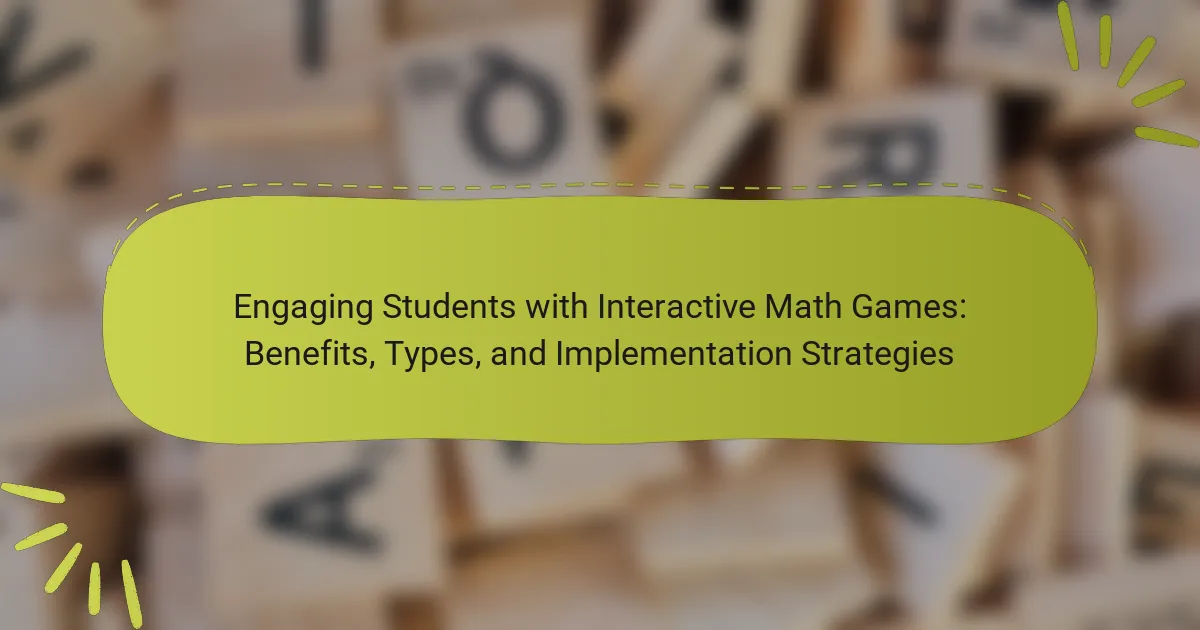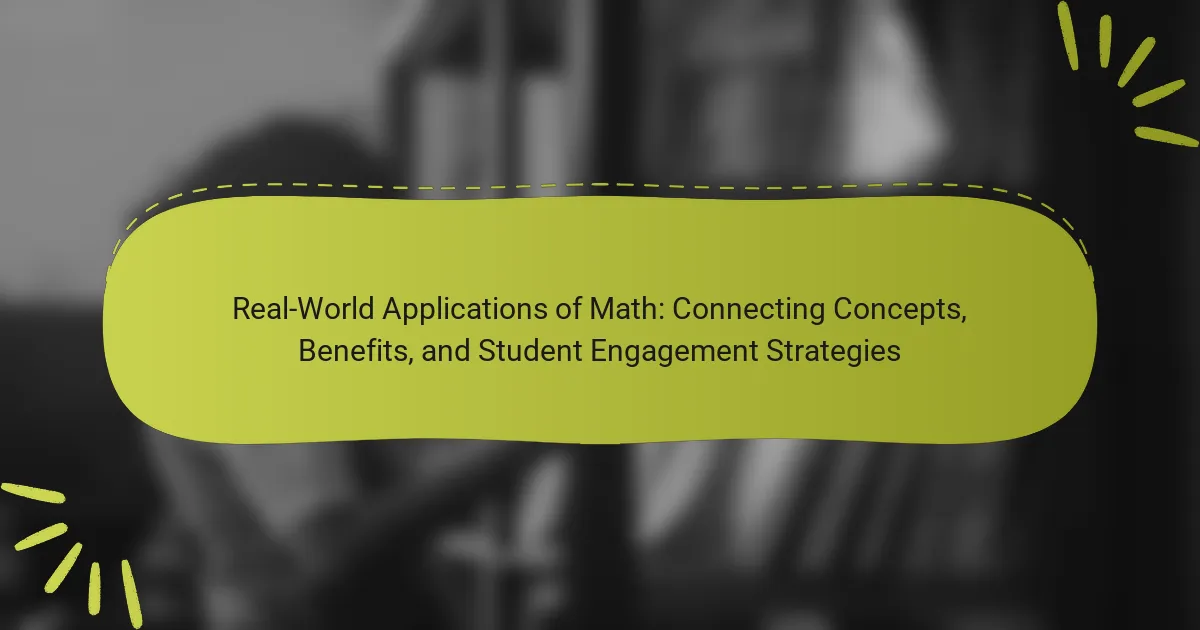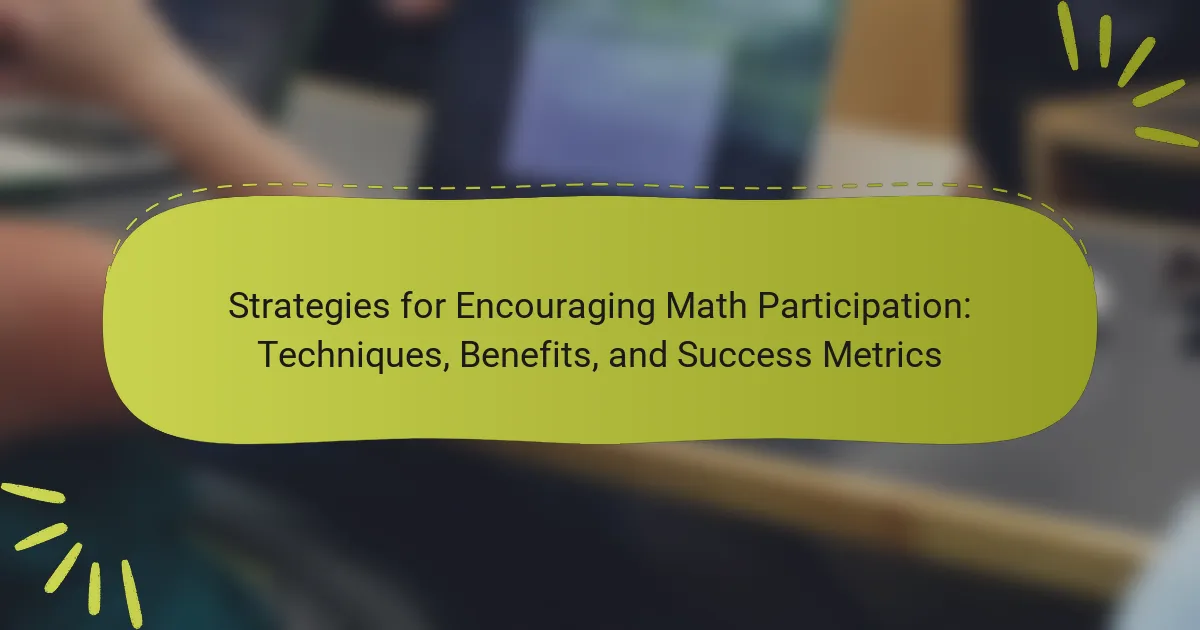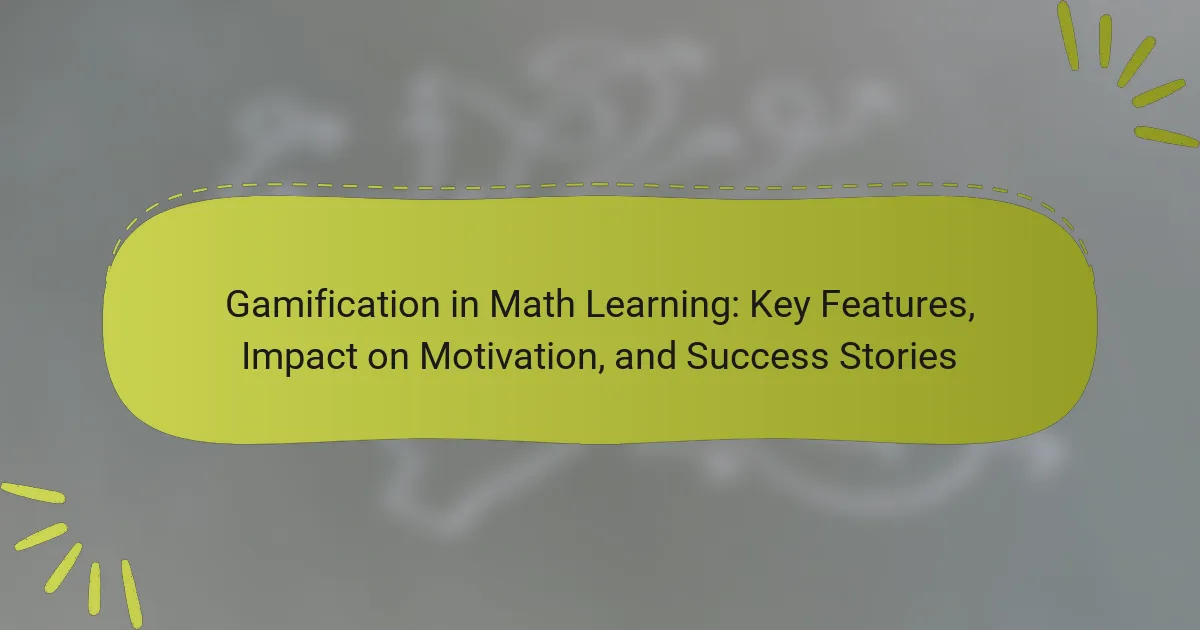The article focuses on the integration of technology in math classrooms, highlighting various digital tools and their benefits for enhancing student engagement and understanding. It discusses interactive software, online platforms, and educational apps that facilitate the visualization of complex mathematical concepts. Key practices for teachers include providing clear instructions, assessing student progress with technology, and encouraging collaboration among students. Research indicates that technology can improve student performance and achievement in mathematics, making it a valuable resource for educators.
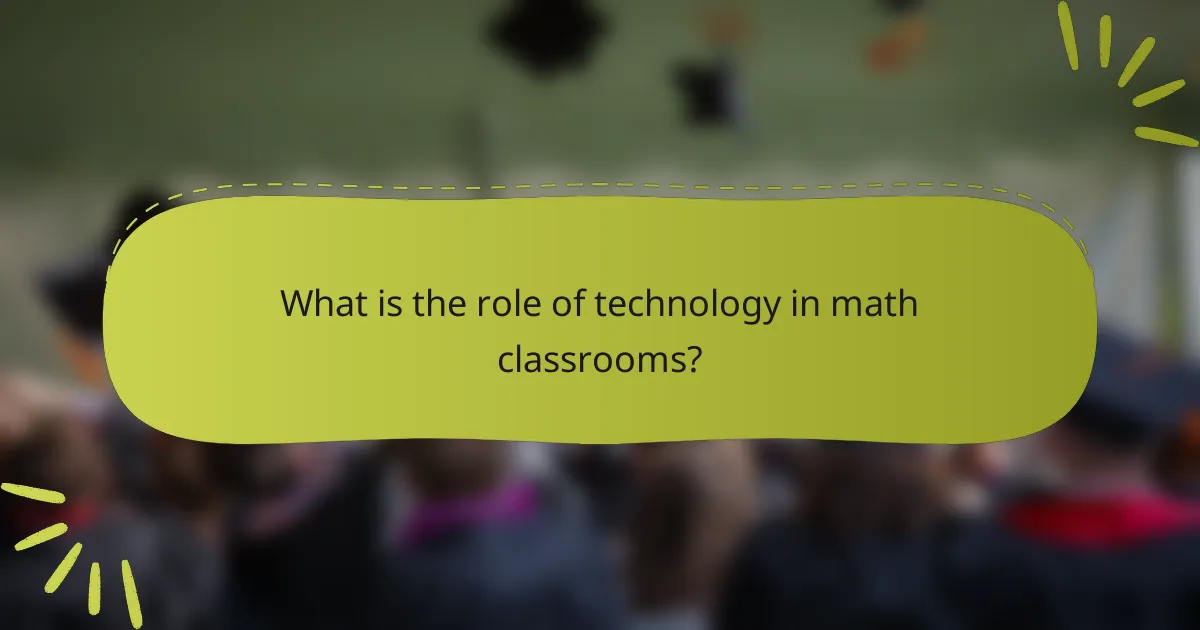
What is the role of technology in math classrooms?
Technology enhances the learning experience in math classrooms. It provides interactive tools that facilitate understanding of complex concepts. Digital resources like software and applications allow for visualization of mathematical problems. Students can engage with math through simulations and games, making learning more enjoyable. Technology also supports personalized learning, catering to individual student needs. Classroom technology enables instant feedback, helping students to identify and correct mistakes promptly. Research indicates that technology integration can improve student performance in mathematics. A study by the National Education Association found that technology in education can lead to higher engagement and achievement levels.
How does technology enhance the learning experience in math?
Technology enhances the learning experience in math by providing interactive tools that engage students. Digital platforms allow for real-time feedback, which helps students understand concepts better. Visualization tools, like graphing software, make abstract concepts more tangible. Gamification of math problems increases motivation and participation among students. Online resources offer personalized learning paths tailored to individual student needs. Collaborative tools enable group work and peer learning, fostering a community of support. Research shows that students using technology perform better in assessments, as it reinforces learning through various modalities. For instance, a study by the U.S. Department of Education found that technology can lead to higher student achievement in math when integrated effectively.
What types of technology are commonly used in math education?
Commonly used technologies in math education include interactive whiteboards, graphing calculators, and educational software. Interactive whiteboards facilitate dynamic presentations and student engagement. Graphing calculators allow students to visualize complex equations and functions. Educational software offers personalized learning experiences and interactive problem-solving. Online platforms provide resources for practice and assessment. Virtual manipulatives enhance understanding of mathematical concepts through simulations. These technologies support diverse learning styles and improve student outcomes.
How do different technologies cater to various learning styles in math?
Different technologies cater to various learning styles in math by providing diverse methods of engagement. Visual learners benefit from interactive simulations and visual aids. These tools help illustrate complex concepts through graphs and animations. Auditory learners gain from podcasts and video lectures that explain mathematical principles. Kinesthetic learners thrive with hands-on tools, such as manipulatives and interactive math games.
Adaptive learning technologies personalize math instruction based on individual progress. Research shows that personalized learning increases student engagement and understanding. For example, platforms like Khan Academy adjust content to fit the learner’s pace. Additionally, collaborative tools like Google Classroom encourage social learning, appealing to those who learn best through discussion and teamwork.
Overall, technology enhances math education by addressing the unique needs of different learning styles. This approach fosters a more inclusive and effective learning environment.
What are the key benefits of utilizing technology in math classrooms?
Utilizing technology in math classrooms enhances student engagement and understanding. Interactive tools, such as software and apps, foster active participation. Students can visualize complex concepts through simulations and graphics. Technology allows for personalized learning experiences tailored to individual needs. Instant feedback from digital platforms helps students identify areas for improvement. Collaborative tools enable group work and peer learning, enhancing social skills. Data from studies show that technology integration can improve test scores by up to 30%. Overall, technology transforms traditional teaching methods, making math more accessible and enjoyable for students.
How does technology improve student engagement in math?
Technology improves student engagement in math by providing interactive and personalized learning experiences. Tools like educational software and apps allow students to visualize complex concepts. Gamification elements in these tools make learning more enjoyable. Real-time feedback helps students understand their mistakes immediately. Collaborative platforms facilitate group work and peer interaction. Research shows that technology can increase motivation and participation. A study by the Bill & Melinda Gates Foundation found that blended learning models enhance student achievement. These factors contribute to a more engaging math learning environment.
What impact does technology have on student performance in math?
Technology positively impacts student performance in math. It enhances engagement through interactive tools and resources. Students using technology show improved understanding of complex concepts. For instance, research by the U.S. Department of Education found that technology can lead to higher test scores in math. Additionally, adaptive learning software personalizes instruction, catering to individual learning paces. This customization helps students grasp difficult topics more effectively. Moreover, technology facilitates collaborative learning, allowing students to work together on math problems. Overall, these factors contribute to improved student outcomes in mathematics.
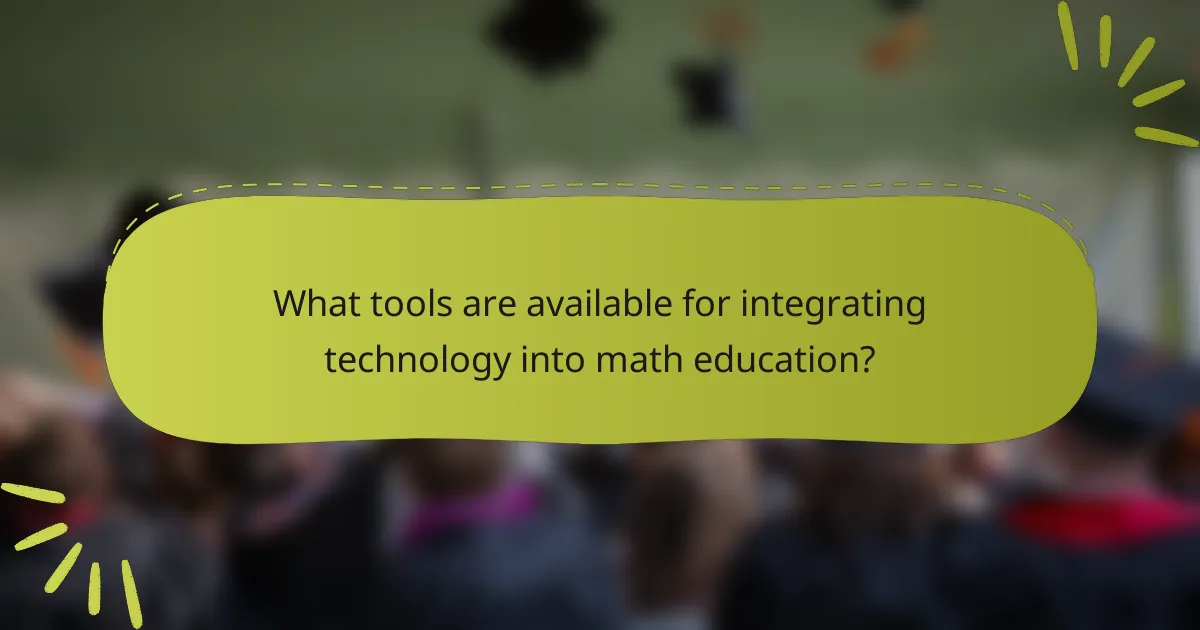
What tools are available for integrating technology into math education?
Digital tools for integrating technology into math education include interactive software, online platforms, and educational apps. Interactive software like GeoGebra allows students to visualize mathematical concepts. Online platforms such as Khan Academy provide video tutorials and practice exercises. Educational apps, like Photomath, enable students to solve problems using their smartphones. These tools enhance engagement and understanding in math. Research shows that technology integration can improve student outcomes in mathematics. For example, a study by the U.S. Department of Education found that technology use in classrooms leads to higher achievement levels.
What are the most effective software and applications for math instruction?
Effective software and applications for math instruction include Khan Academy, IXL, and GeoGebra. Khan Academy offers a comprehensive library of instructional videos and practice exercises. IXL provides personalized learning with adaptive questions based on student performance. GeoGebra combines geometry, algebra, and calculus in an interactive platform.
Research shows that using these tools can enhance student engagement and improve understanding of mathematical concepts. A study by the Bill & Melinda Gates Foundation found that technology integration in math instruction leads to better student outcomes. These applications support differentiated learning, catering to various skill levels and learning styles.
How can interactive whiteboards be used in teaching math?
Interactive whiteboards can be used in teaching math by enhancing engagement and facilitating interactive learning. They allow teachers to display dynamic visual aids like graphs and equations. Students can participate directly by solving problems on the board. This interaction helps reinforce concepts through hands-on practice. Additionally, teachers can use software to create interactive lessons tailored to various math topics. Research shows that using interactive whiteboards can improve student performance and motivation in math. A study by Hattie (2009) indicates that technology integration in classrooms positively impacts learning outcomes.
What role do online platforms play in math learning?
Online platforms enhance math learning by providing interactive resources and personalized instruction. They offer access to a variety of educational materials, including videos, quizzes, and practice problems. These platforms facilitate real-time feedback, allowing students to identify and address their weaknesses. Many online tools incorporate gamification, making learning more engaging. Research shows that students using online platforms often demonstrate improved performance in math. For instance, a study by the International Society for Technology in Education found that technology integration positively impacts student achievement in mathematics. Overall, online platforms play a crucial role in modern math education by supporting diverse learning styles and promoting active participation.
What hardware is essential for a technology-rich math classroom?
Essential hardware for a technology-rich math classroom includes interactive whiteboards, computers, and tablets. Interactive whiteboards allow for dynamic presentations and student engagement. Computers provide access to software and online resources for mathematical learning. Tablets enable personalized learning experiences and interactive applications. Additionally, calculators are crucial for performing complex calculations. Projectors can enhance visual learning by displaying content to the entire class. Document cameras facilitate the sharing of student work and problem-solving processes. These tools collectively enhance the learning environment and improve student involvement in math education.
How do tablets and laptops enhance math learning opportunities?
Tablets and laptops enhance math learning opportunities by providing interactive and personalized learning experiences. These devices enable access to a wide range of educational apps and software designed for math practice. Students can engage with dynamic visualizations that illustrate complex mathematical concepts. Immediate feedback from these tools helps students identify areas for improvement. Tablets and laptops also facilitate collaborative learning through shared digital platforms. Research shows that technology integration in math education can lead to improved student engagement and achievement. A study by the U.S. Department of Education found that technology use in classrooms positively impacts student learning outcomes.
What are the advantages of using calculators and graphing tools in math?
Calculators and graphing tools enhance mathematical learning by improving accuracy and efficiency. They allow for quick computations, reducing time spent on basic arithmetic. This efficiency enables students to focus on problem-solving and conceptual understanding. Graphing tools visually represent functions and data, aiding in comprehension of complex concepts. Studies show that students using technology perform better in math assessments. Additionally, these tools foster engagement and motivation among learners. They provide immediate feedback, helping students identify and correct mistakes promptly. Overall, calculators and graphing tools support diverse learning styles and promote a deeper understanding of mathematics.
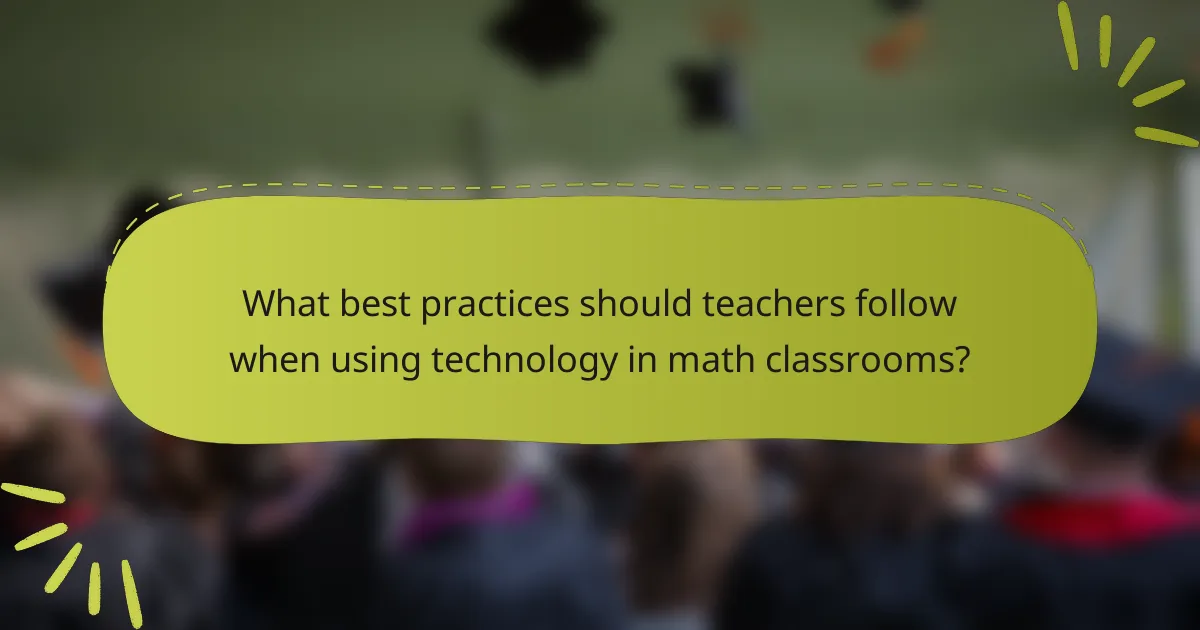
What best practices should teachers follow when using technology in math classrooms?
Teachers should integrate technology in math classrooms by using interactive tools. Interactive tools enhance student engagement and understanding. Examples include digital whiteboards, math software, and online resources. Teachers should provide clear instructions for using these tools. This clarity helps students navigate technology effectively. Regularly assessing student progress with technology is essential. Assessment tools can provide immediate feedback for both students and teachers. Collaboration is another key practice. Encouraging students to work together using technology fosters peer learning. Lastly, teachers should stay updated on new technologies. Continuous learning ensures teachers can provide the best resources available.
How can teachers effectively integrate technology into their lesson plans?
Teachers can effectively integrate technology into their lesson plans by incorporating digital tools that enhance learning. They can use interactive software to facilitate problem-solving in math. For instance, platforms like GeoGebra allow students to visualize mathematical concepts. Teachers can also implement online quizzes for immediate feedback. These quizzes can track student progress in real-time. Additionally, using educational apps can foster collaboration among students. Tools like Google Classroom enable seamless sharing of resources and assignments. Research shows that technology can increase student engagement by 30%. This statistic highlights the positive impact of technology in education.
What strategies can be employed to ensure all students benefit from technology?
To ensure all students benefit from technology, educators should implement inclusive strategies. These strategies include providing access to devices for every student. Schools can establish programs to lend technology to those in need. Training teachers on diverse technology tools is essential. Professional development can enhance teachers’ abilities to integrate technology effectively. Differentiated instruction using technology caters to various learning styles. Tools like interactive software allow personalized learning experiences. Regular assessments can measure technology’s impact on student engagement. Data from studies shows that technology improves learning outcomes when used effectively.
How can teachers assess the effectiveness of technology in their math instruction?
Teachers can assess the effectiveness of technology in their math instruction through various methods. They can analyze student performance data before and after technology integration. This includes comparing test scores and understanding levels. Surveys can gather student feedback on their engagement and comprehension. Observations during lessons can provide insights into student interactions with technology. Teachers can also use formative assessments to gauge real-time understanding. Additionally, reviewing lesson plans and objectives can help evaluate alignment with technology use. Research indicates that incorporating technology can lead to improved student outcomes. For example, a study by the National Education Association found that technology-enhanced instruction can increase student achievement by 30%.
What challenges might educators face when implementing technology in math classrooms?
Educators face several challenges when implementing technology in math classrooms. One major challenge is the lack of adequate training for teachers. Many educators are not familiar with how to effectively integrate technology into their teaching practices. This can lead to ineffective use of tools and resources. Another challenge is the disparity in access to technology among students. Some students may not have reliable internet or devices at home, creating an equity gap. Additionally, there can be resistance from both educators and students to adopt new technologies. This resistance can stem from a fear of change or a lack of confidence in using new tools. Technical issues, such as software malfunctions or hardware failures, can also disrupt lessons. Finally, aligning technology with curriculum standards can be complex. Educators must ensure that the tools they use support learning objectives and enhance student understanding.
How can teachers overcome resistance to technology among students?
Teachers can overcome resistance to technology among students by integrating technology into engaging lessons. They should demonstrate the relevance of technology to students’ interests and future careers. Providing hands-on experiences with technology can also increase comfort and familiarity. Encouraging collaboration through technology fosters a supportive learning environment. Offering training sessions can help students build confidence in using new tools. Addressing specific concerns or fears about technology can alleviate anxiety. Research shows that when students see the practical benefits of technology, their resistance decreases significantly. A study by the International Society for Technology in Education found that student engagement increases when technology is used effectively in classrooms.
What are common technical issues that may arise and how can they be resolved?
Common technical issues in math classrooms include software malfunctions, connectivity problems, and hardware failures. Software malfunctions can arise from outdated applications or compatibility issues. To resolve this, ensure all software is updated regularly and check compatibility with devices. Connectivity problems often occur due to weak Wi-Fi signals or network outages. Strengthening the Wi-Fi signal and having backup internet options can mitigate these issues. Hardware failures may involve malfunctioning projectors or interactive whiteboards. Regular maintenance and having spare equipment on hand can help address these failures quickly. Additionally, providing training for teachers on troubleshooting can empower them to resolve minor issues independently.
What tips can educators follow for successful technology integration in math classrooms?
Educators can follow several tips for successful technology integration in math classrooms. First, they should align technology use with learning objectives. This ensures that the tools enhance the curriculum. Second, educators must provide professional development for themselves. Training helps teachers become proficient in using new technologies. Third, they should involve students in the selection of tools. This increases student engagement and ownership of their learning. Fourth, educators can use technology for formative assessments. Tools like quizzes and interactive software provide immediate feedback. Fifth, they should encourage collaboration through technology. Platforms that allow group work can enhance problem-solving skills. Lastly, educators must regularly evaluate the effectiveness of technology. This ensures that the tools are meeting educational goals.
The main entity of this article is the integration of technology in math classrooms, which significantly enhances student engagement and learning outcomes. The article outlines various types of technology commonly used in math education, such as interactive whiteboards, educational software, and online platforms, highlighting their roles in facilitating personalized learning and immediate feedback. Key benefits include improved understanding of complex concepts, increased motivation through gamification, and enhanced collaboration among students. Best practices for educators are also discussed, focusing on effective strategies for technology integration, assessment methods, and overcoming challenges related to technology use in the classroom.
